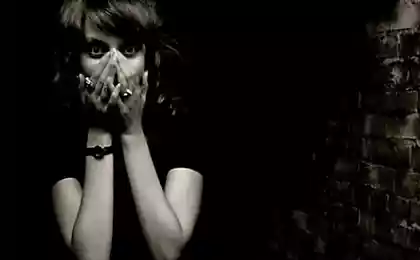194
7 Phobias Born of the Internet and Gadgets
We live in a world of our fears. Fear of enclosed spaces, darkness, or heights is yesterday. Today, people are driven crazy by Internet trolling, a forgotten smartphone or the lack of likes under the photo on social networks. We tried to penetrate the world of phobias of modern man and identified 7 phobia-consequences of NTP.
Nomophobia
Have you ever forgotten your mobile phone at home or in your car? If you have experienced discomfort, anxiety and a sense of fear, with a high probability you suffer from nomophobia - the plague of the XXI century. The term is derived from the English phrase “no mobile phone” and translates as the fear of being left without a mobile phone. Scientists identified the disease in a 2008 study that found that 66 percent of every 100 people experienced panic anxiety without communication. They tried to constantly check for missed calls, messages and emails.
It is worth noting that in 2008, the era of touch-sensitive smartphones with fast Internet access has not yet begun. And if then the phobia suffered more than half of the population, now the disease must have spread to everyone. Try to check yourself: turn off your phone for at least one day.
Cyberphobia
The personal computer is the main companion of life in the modern world, so the appearance of fear of a computer or cyberphobia is quite natural. If nomophobia is a disease of the young, cyberphobia is more common among older people who are forced to learn new techniques. Doctors distinguish such symptoms of cyberphobia:
Socionetophobia
The fear of social networks is a modern version of the fear of persecution, which manifests itself in the fear of having an account on social networks, as it can be used for blackmail or surveillance. It does not have to be special services, it is enough that people from close circles can get acquainted with personal data - family members, customers or superiors. However, socionetophobia is easy to treat. According to psychologist Jay Bayer, the patient needs to create an account that would correspond to his comfort zone, for example, in a group with the same hobbies.
Trollephobia
Every Internet user knows the concept of a troll. And everyone knows that feeding them is not worth it, banning them is useless, it is easiest to just ignore. However, the active growth of the troll population has recently caused a response - trollephobia or trolleparana. The patient is sure that all readers, commentators, members of his blog or portal are trolls whose goal is to destroy the project. Hence the desire not to attract excessive attention and the desire for anonymity. Unfortunately, there is no cure for trollephobia yet. Psychologists recommend trying not to succumb to provocations - do not "feed" trolls.
Imojiphobia
One of the brightest examples of modern fears, which appeared as a result of the spread of social networks, messengers and chats. A person suffering from Imojiphobia is afraid that he will be misunderstood, or that he “out of place” put a familiar emoji or sticker. Imojiphobia can hardly be called a serious mental disorder, it is only a new form of psychosis, which is selective and temporary. It is believed that every Internet user has a bit of imojiphobe: often in online communication you have to conduct both official and personal correspondence, not everyone has time to quickly switch from a representative tone.
self-phobia
This phobia, despite its comical nature, has already sent its first tantrum to the hospital. At the end of March 2014, 19-year-old British Daniel Bowen was hospitalized after spending six months without leaving home in search of the perfect selfie (photo taken in person on a mobile phone). The guy took 200 photos every day – he was kicked out of school, he lost a lot of weight, and, in the end, decided to commit suicide. Fortunately, he did not succeed in the latter.
According to doctors, selfie preoccupation is a serious psychological problem of our time, which necessarily requires medical intervention. By the way, Danny Bowen was cured, after weaned to constantly use a smartphone.
Tredophobia
The meaning of the word thread in this context is a branch of comments in social networks. The phobia, accordingly, is expressed in the fear of commenting, for example, to express their opinion. Tredophobia is usually shy even in life, only online this is aggravated, because if the comment suddenly turns out to be out of place, insults and criticism will fall. Such patients are prescribed anonymity: try to create an account on behalf of a fictional character to overcome the internal barrier. The main thing here is not to bend a stick, so as not to hit the Internet trolling. Remember, if you shock the audience, it is more likely to cause hatred than recognition.
Partner material: Estet-portal
Source: estet-portal.com
Nomophobia
Have you ever forgotten your mobile phone at home or in your car? If you have experienced discomfort, anxiety and a sense of fear, with a high probability you suffer from nomophobia - the plague of the XXI century. The term is derived from the English phrase “no mobile phone” and translates as the fear of being left without a mobile phone. Scientists identified the disease in a 2008 study that found that 66 percent of every 100 people experienced panic anxiety without communication. They tried to constantly check for missed calls, messages and emails.
It is worth noting that in 2008, the era of touch-sensitive smartphones with fast Internet access has not yet begun. And if then the phobia suffered more than half of the population, now the disease must have spread to everyone. Try to check yourself: turn off your phone for at least one day.
Cyberphobia
The personal computer is the main companion of life in the modern world, so the appearance of fear of a computer or cyberphobia is quite natural. If nomophobia is a disease of the young, cyberphobia is more common among older people who are forced to learn new techniques. Doctors distinguish such symptoms of cyberphobia:
- The person behaves extremely carefully with the PC;
- speaks negatively about the computer;
- avoids computers.
Socionetophobia
The fear of social networks is a modern version of the fear of persecution, which manifests itself in the fear of having an account on social networks, as it can be used for blackmail or surveillance. It does not have to be special services, it is enough that people from close circles can get acquainted with personal data - family members, customers or superiors. However, socionetophobia is easy to treat. According to psychologist Jay Bayer, the patient needs to create an account that would correspond to his comfort zone, for example, in a group with the same hobbies.
Trollephobia
Every Internet user knows the concept of a troll. And everyone knows that feeding them is not worth it, banning them is useless, it is easiest to just ignore. However, the active growth of the troll population has recently caused a response - trollephobia or trolleparana. The patient is sure that all readers, commentators, members of his blog or portal are trolls whose goal is to destroy the project. Hence the desire not to attract excessive attention and the desire for anonymity. Unfortunately, there is no cure for trollephobia yet. Psychologists recommend trying not to succumb to provocations - do not "feed" trolls.
Imojiphobia
One of the brightest examples of modern fears, which appeared as a result of the spread of social networks, messengers and chats. A person suffering from Imojiphobia is afraid that he will be misunderstood, or that he “out of place” put a familiar emoji or sticker. Imojiphobia can hardly be called a serious mental disorder, it is only a new form of psychosis, which is selective and temporary. It is believed that every Internet user has a bit of imojiphobe: often in online communication you have to conduct both official and personal correspondence, not everyone has time to quickly switch from a representative tone.
self-phobia
This phobia, despite its comical nature, has already sent its first tantrum to the hospital. At the end of March 2014, 19-year-old British Daniel Bowen was hospitalized after spending six months without leaving home in search of the perfect selfie (photo taken in person on a mobile phone). The guy took 200 photos every day – he was kicked out of school, he lost a lot of weight, and, in the end, decided to commit suicide. Fortunately, he did not succeed in the latter.
According to doctors, selfie preoccupation is a serious psychological problem of our time, which necessarily requires medical intervention. By the way, Danny Bowen was cured, after weaned to constantly use a smartphone.
Tredophobia
The meaning of the word thread in this context is a branch of comments in social networks. The phobia, accordingly, is expressed in the fear of commenting, for example, to express their opinion. Tredophobia is usually shy even in life, only online this is aggravated, because if the comment suddenly turns out to be out of place, insults and criticism will fall. Such patients are prescribed anonymity: try to create an account on behalf of a fictional character to overcome the internal barrier. The main thing here is not to bend a stick, so as not to hit the Internet trolling. Remember, if you shock the audience, it is more likely to cause hatred than recognition.
Partner material: Estet-portal
Source: estet-portal.com























